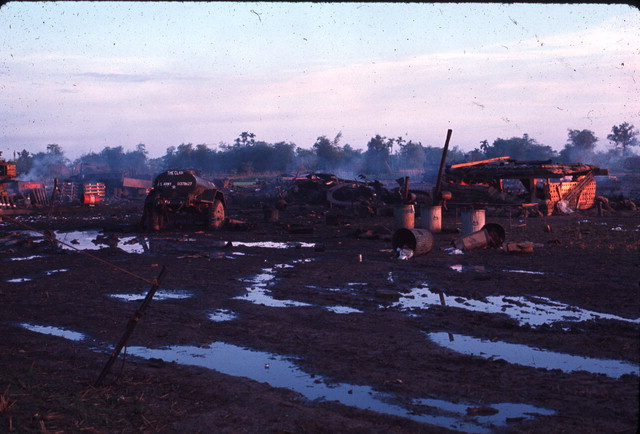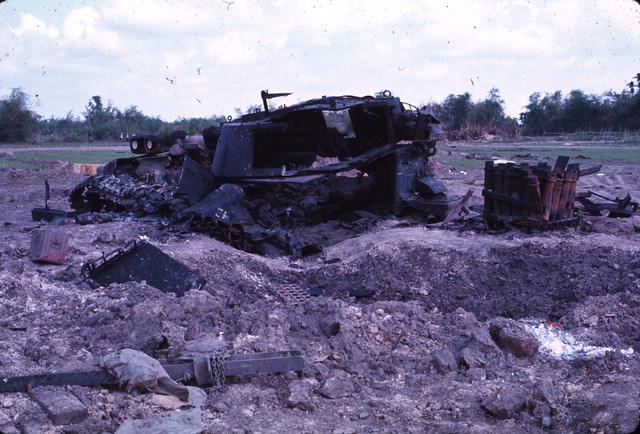BATTLE OF FIRE SUPPORT BASE MAURY I
This page is dedicated to the young soldiers that gave their lives in defense of FSB Maury. 1st Lt Michael Mitchell, B Btry 7/11th, 24 yrs old, Houston TX., Died from multiple fragmentation woundsPFC Edward Tyler, HHB 7/11th, 21 yrs old, Oklahoma City, OK, Died from multiple fragmentation woundsSP5 Michael Brewer, HHB, 7/11th, 23 yrs old, Frederick, MD, Died from multiple fragmentation woundsCPL Dwight Bozeman, A/3/13th, 22 yrs old, Cochran, GA, Died from multiple fragmentation woundsSSG Excell Ficklin, A/3/13th, 32 yrs old, Morton, MS, Died from burnsSgt Timothy Hamilton, A/3/13th, 23 yrs old, Streator, IL, Died from burns.PFC Rudy Lopez, A/3/13th, 20 yrs old, Austin, TX, Died from burns.PFC Marvin Martin, A/3/13th, 24 yrs old, Scottsbluff, NE, Died from Multiple fragmentation wounds.PFC Garrett O'Conner, A/3/13th, 19 yrs old, Warren, MI, Died from multiple fragmentation woundsSSG Cornealus Pumphrey, Jr, A/3/13th, 28 yrs old, Corcoran, CA, Died of multiple fragmentation wounds SP5 Leo Rupert, A/3/13th, 28 yrs old, Newberg, MO, Died of multiple fragmentation wounds.SP4 Reid Styers, A/3/13th, 24 yrs old, Berkley Springs, WV, Died of burns.Sp4 Edward Baglini, HHB/7/11th, 21 yrs old, N. Providence Rhode Island, Died of multiple fragmentation wounds. During the period 9 - 12 May 1968, two fire support bases of the 25th Infantry Division Artillery came under intense enemy attack. The two attacks followed classic VC tactics and accordingly were almost identical in nature. The defense of both bases by US troops was also successful in each case, but lessons learned from the first defense, applied to the defense of the second fire support base resulted in far less destruction of friendly equipment and fewer friendly casualties.
The fire support base designated as Maury I was composed of two 105mm towed howitzer batteries, B Battery, 7th Battalion, 11th Artillery and C Battery, 7th Battalion, 11th Artillery and one 155mm SP howitzer battery, A 3/13. The battalion fire direction center of the 7/11 Arty was controlling fires in the base, and attached to it were two 40mm “dusters” from the 5/2 Arty. Although Maury I was located in what was probably the best available area in its immediate vicinity, the terrain was far from ideal. Hedgerows, bamboo thickets and woodlines surrounded the clear area, and adding to the difficulty of prepar9ing the position was the advent of the monsoon season, making digging underground bunkers difficult.
At 0100 hours on 9 May 1968, Captain Kendall Jowers, battery commander of C, 7/11 Arty was finally preparing to take some much needed rest. He knew it would be short, for he had left word to be awakened when the guard in the exec post changed at 0200 hours. Shortly prior to 0200 hours, Captain Jowers was shaken awake by his radio operator and staggered over to the exec post bunker just in time to glance at his watch, verify the 0200 hours switch-over, and listen to the first mortar round explode outside the doorway.
While Captain Jowers and his men were pinned down by the intense mortar and RPC barrage, the enemy was beginning its ground assault. After launching two diversionary attacks against the northwestern and southwestern corners of the fire support base, the main attack was directed against the western point of the triangle where the 155mm battery nestled less than 200 meters from a treeline.
By 0330 hours 1st Lt Robert McLaughlin, the fire direction officer of C, 7/11 Arty, was frantically moving two 105mm howitzers to the southwestern side of the perimeter, hoping to relieve some of the pressure against the 155mm battery with the 105mm beehive round. But as this move was being executed, the RPC fire was having a devastating effect on the 155mm howitzers. Only one M109 was still serviceable, and out of the other five, three had been completely destroyed.
Captain Luis Ortiz, the battery commander of the medium battery, was on his second trip to the battalion fire direction center when he noticed one of the M548 ammunition tracks burning. Oddly enough though, the M548 which had been adjacent to the burning track was missing, and not until daylight would Captain Ortiz learn that the missing track was spread over the entire position in minute particles.
(p15)
The flare and gunships arrived by 0330 hours, the Air Force fighter aircraft by 0500 hours. At 0530 hours the relief elements of LTC A.S. Fullerton's 4th Battalion, 23rd Mechanized Infantry Battalion, which had been racing to Maury from their night position since news of the attack had been broadcast, finally battered their way into the beleaguered base, and the din of battle sputtered to a halt. As the dazed defenders of Maury I picked their way through the expended canisters, wounded comrades awaiting evacuation and widespread debris, the initial accounting of men and ammunition was begun.
All beehive ammunition had been expended, but due to the speed and accuracy of the assault against the medium battery, less than 10 rounds of 155mm had been fired prior to the destruction of the howitzers. The Dusters had done well. From protected berm positions, the two M-42's had expended a total of 1100 40mm rounds, resulting in at least two secondary explosions, despite the RPC wounds received by four crewmen.
Only 18 confirmed Viet Cong killed could be determined, and friendly losses numbered 10 killed and 66 wounded, of which 4 men later died of wounds received in the battle. These four men, along with seven others killed and thirty-nine wounded, were all artillerymen. Of the five M109's destroyed, one serviceable howitzer was pieced together from two damaged howitzers. Two M548s were destroyed, and one five ton truck was severely damaged. Also, fourteen M-16 rifles were either lost or destroyed, and a few gas tanks ruptured.



